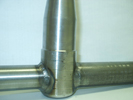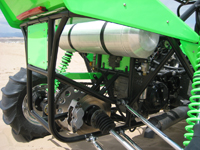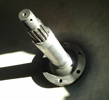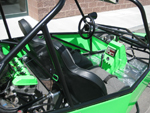by
Pete@DumontDuneRiders.com
June 1, 2008
 Short Sand Cars
has been
building
motorcycle
powered
sandrails since
the early to mid
90's. Each and
every one of
their cars they
build are custom
tailored to
their customer's
desires. Nothing
but dedication
and attention to
detail goes into
the cars they
build. As a
return customer,
it was time for
us at DDR to
build a one
of a kind
Short Sand Car. Short Sand Cars
has been
building
motorcycle
powered
sandrails since
the early to mid
90's. Each and
every one of
their cars they
build are custom
tailored to
their customer's
desires. Nothing
but dedication
and attention to
detail goes into
the cars they
build. As a
return customer,
it was time for
us at DDR to
build a one
of a kind
Short Sand Car.
Some people
build Hayabusa
rails mostly for
hill shooting.
They make them
extremely light
and build up a
very high
horsepower
turbo-charged
Hayabusa to
annialate most
full size cars
at Comp Hill.
Well, that was
not goal with
this car. We
were more
focused on
duning this
machine. The
main objective
with this car
was to build an
extremely strong
sandcar that
could withstand
the aggressive
duning abuse and
steep terrain of
Dumont Dunes.
With safety
always a
concern, we
wanted to make
it as safe as
possible for
years of duning
pleasure.

The build
started with
choosing a
strong tubing
for the chassis.
Most of their
cars are built
from mild steel.
We opted to go
with .095" 4130
chromolly tubing
instead. It
costs slightly
more, but it is
well worth it in
our eyes. The
frame had
multiple gussets
added including
b-pillars and an
x-braced front
end and roof.
Slightly larger
than normal
diameter tubing
was used in
places like the
frame cross
bracing and the
bar behind the
seats that the
seatbelt
harnesses mount
to. Adding this
extra bracing
helps maintain
the frame's
integrity and
makes it much more
rigid for
aggressive
driving, not to
mention safer.
All the
suspension on
this car was
also constructed
out of 4130
chromolly. 1
1/8" diameter
front a-arms
connect to
custom made
chromolly
spindles. The
spindle shafts
 are
larger than even
those of some
full-size cars
which are
usually are
larger than even
those of some
full-size cars
which are
usually 1 1/4". They
feature the same
design using a
rolled radius
edge as seen
with a
combo spindle,
but instead use
a slightly
larger custom 1 3/8"
shaft. Then the
steering arms
were boxed in
and gussets were
added for
lateral support
for those hard
turns. Fox 2.0
coil over shocks
were used
instead of air
shocks (which
some people
commonly use).
These provide a
more stabile and
controlled ride
height which is
needed for those
hard "g-outs"
and transitions
that you can come
up on
unexpectedly
during a ride. To
also help with
stability, 15"
Douglas wheels
were used at all
4 corners. The
front tires are
6.75x15"
smoothies. These
tires keep the
"sand in your
face factor" to
a minimum while
still providing
plenty of
footprint for
excellent
turning ability.
The rear paddles
on this car are
13.00x15" comp
cut Sand
Squirts. They
are a very good
all-around tire
that provide
plenty of hookup
while still
offering
sufficient
flotation on the
sand.
1 1/4". They
feature the same
design using a
rolled radius
edge as seen
with a
combo spindle,
but instead use
a slightly
larger custom 1 3/8"
shaft. Then the
steering arms
were boxed in
and gussets were
added for
lateral support
for those hard
turns. Fox 2.0
coil over shocks
were used
instead of air
shocks (which
some people
commonly use).
These provide a
more stabile and
controlled ride
height which is
needed for those
hard "g-outs"
and transitions
that you can come
up on
unexpectedly
during a ride. To
also help with
stability, 15"
Douglas wheels
were used at all
4 corners. The
front tires are
6.75x15"
smoothies. These
tires keep the
"sand in your
face factor" to
a minimum while
still providing
plenty of
footprint for
excellent
turning ability.
The rear paddles
on this car are
13.00x15" comp
cut Sand
Squirts. They
are a very good
all-around tire
that provide
plenty of hookup
while still
offering
sufficient
flotation on the
sand.
 As
for the
powertrain, this
car uses a
stock
Suzuki 1300cc Hayabusa
motorcycle
engine. It
produces about
175 horsepower
which is plenty
of power to
blast the 1000
pound machine
through the
dunes. As for
the 6 speed
transmission, it
is all
integrated with
the engine
assembly since
it is a
motorcycle
engine. It is
all mostly stock
with the
exception of
undercut gears
which As
for the
powertrain, this
car uses a
stock
Suzuki 1300cc Hayabusa
motorcycle
engine. It
produces about
175 horsepower
which is plenty
of power to
blast the 1000
pound machine
through the
dunes. As for
the 6 speed
transmission, it
is all
integrated with
the engine
assembly since
it is a
motorcycle
engine. It is
all mostly stock
with the
exception of
undercut gears
which
 provide
improved holding
power while
under
acceleration and
also offer a
more positive
shift. The
transmission transfers it's
power via a 530
X-ring chain to
a heavy-duty 63
tooth rear
custom sprocket
by Sprocket
Specialties.
Then there are
930 c.v axles
that connect to
race strength
steel hubs and
custom stub
axles. provide
improved holding
power while
under
acceleration and
also offer a
more positive
shift. The
transmission transfers it's
power via a 530
X-ring chain to
a heavy-duty 63
tooth rear
custom sprocket
by Sprocket
Specialties.
Then there are
930 c.v axles
that connect to
race strength
steel hubs and
custom stub
axles.
 Moving
to the cockpit,
we used PRP
Premier Highback
seats which have
removable
cushions. These
are nice because
it makes it much
easier to clean
the sand out
after a weekend
at the dunes.
For added
safety, the
seats were hard
mounted instead
of using slider
tracks. There
are 3 seat
adjustment holes
in the frame
should we ever
need to adjust
them for a
shorter driver.
Then a set of 2"
five point Crow
padded harnesses
were installed.
The crotch strap
within the five
point harnesses
add safety and
piece of mind by
keeping the lap
belt from riding
up from the
proper position,
your lap.
A custom console
features an
Intellidash
which displays
all necessary
vitals of the
engine like
coolant temp,
oil pressure,
battery voltage,
charging status,
speedometer, and tach. Just below
the Intellidash,
an LED gear
shift indicator
displays what
gear the car is
in. The console
is also where
all the Moving
to the cockpit,
we used PRP
Premier Highback
seats which have
removable
cushions. These
are nice because
it makes it much
easier to clean
the sand out
after a weekend
at the dunes.
For added
safety, the
seats were hard
mounted instead
of using slider
tracks. There
are 3 seat
adjustment holes
in the frame
should we ever
need to adjust
them for a
shorter driver.
Then a set of 2"
five point Crow
padded harnesses
were installed.
The crotch strap
within the five
point harnesses
add safety and
piece of mind by
keeping the lap
belt from riding
up from the
proper position,
your lap.
A custom console
features an
Intellidash
which displays
all necessary
vitals of the
engine like
coolant temp,
oil pressure,
battery voltage,
charging status,
speedometer, and tach. Just below
the Intellidash,
an LED gear
shift indicator
displays what
gear the car is
in. The console
is also where
all the necessary
switches are
mounted for the
lights, fans,
and ignition.
For lighting, we
used a pair of
Trail Tech SC4
internal ballast
HID's. They come
in 30 and 40
watt setups. We used
the 30 watters
because of the
fairly low
output of the
Hayabusa's
stator. A
slightly larger
than motorcycle
size battery was
used, but we
have plans to
upgrade to
something like a
dry cell Odyssey
battery for more
reserve power
later on.
necessary
switches are
mounted for the
lights, fans,
and ignition.
For lighting, we
used a pair of
Trail Tech SC4
internal ballast
HID's. They come
in 30 and 40
watt setups. We used
the 30 watters
because of the
fairly low
output of the
Hayabusa's
stator. A
slightly larger
than motorcycle
size battery was
used, but we
have plans to
upgrade to
something like a
dry cell Odyssey
battery for more
reserve power
later on.
To finish it off
and give it a
one-of-a-kind/
unique look, we
chose a satin
black powdercoat
from Prismatic
Powders for the
chassis. The
satin look gives
it just enough
"sheen" and
doesn't show as
much sandblast
or scratches as
a
 glossy
black would.
Then to give
this car a
vibrant color
that contrasts
well up against
the satin black,
we went with
Silver Sparkle
over Limelite.
Other than
looking great,
this color also
adds to the
safety factor
that we
were after with
this car. If you
can't see this
thing in the
dunes, then you
really shouldn't
be out there. It
really stands
out and turns
some heads. All
the suspension
arms are chromed
and the four
corners have the
satin black
color for the
spindles and
rear carriers. glossy
black would.
Then to give
this car a
vibrant color
that contrasts
well up against
the satin black,
we went with
Silver Sparkle
over Limelite.
Other than
looking great,
this color also
adds to the
safety factor
that we
were after with
this car. If you
can't see this
thing in the
dunes, then you
really shouldn't
be out there. It
really stands
out and turns
some heads. All
the suspension
arms are chromed
and the four
corners have the
satin black
color for the
spindles and
rear carriers.
The car came out
great and we
were very
anxious to go
test it out! |



